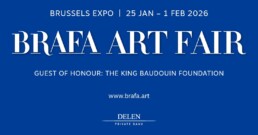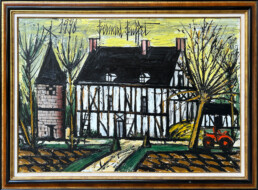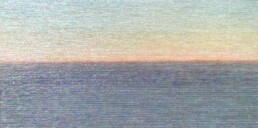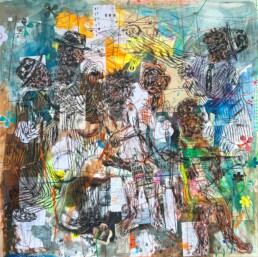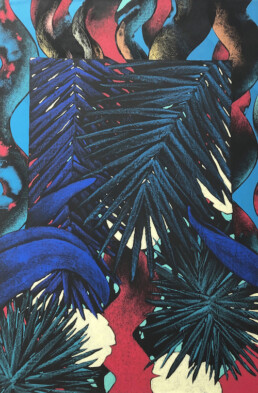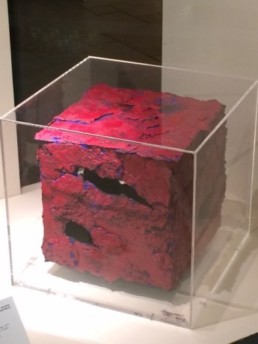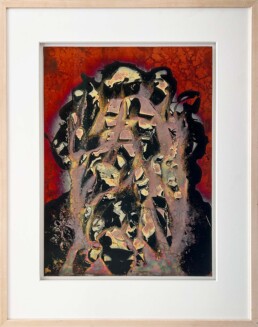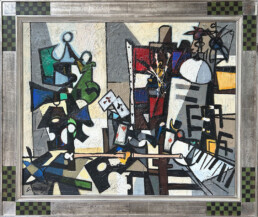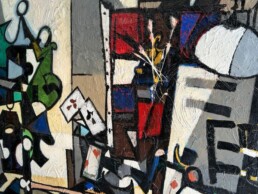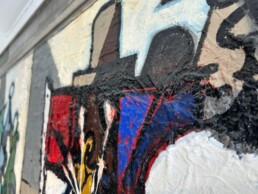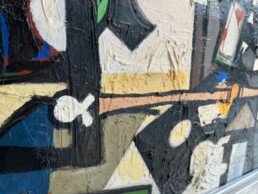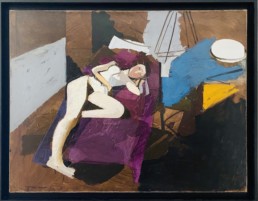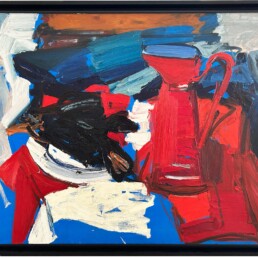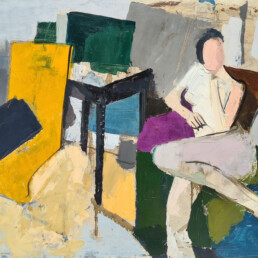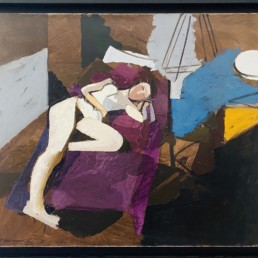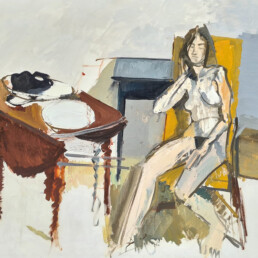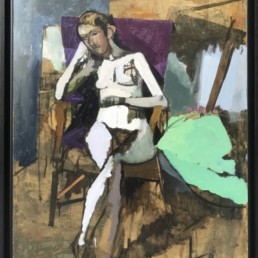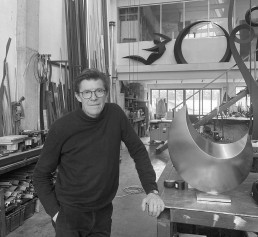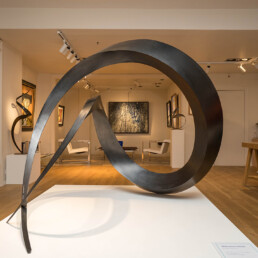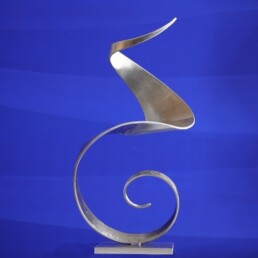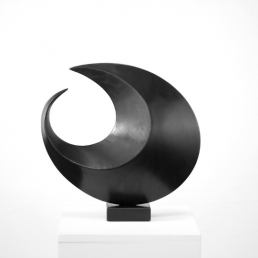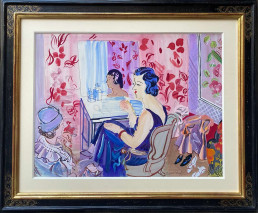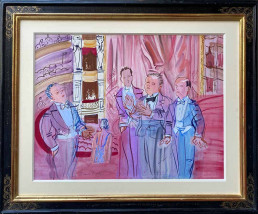BRAFA 2026 : du 25.01 au 01.02.2026
BRAFA 2026
From 25.01 to 01.02.2022
PLACE
HALL 3 Booth 121
BRAFA Art Fair – Brussels Expo (Palais 3 & 4)
Place de Belgique 1
1020 Bruxelles – Belgique
OPENING HOURS
Collectors’ Preview : Friday 23 January 2026 : 12h00 – 22h00
Exclusive Saturday : Saturday 24 January 2026 : 11h00 – 19h00
Public Days : Sunday 25 January to Sunday 01 February 2026 : 11h00 – 19h00
Bernay, Eure (1998) – A work by Bernard Buffet in tribute to Normandy
A painting by Bernard Buffet, a major figure in 20th-century French art
Created in 1998, Bernay, Eure is an oil on canvas painting by Bernard Buffet (1928–1999), an iconic figure in 20th-century French art. A painter of melancholy, incisive lines, and silent landscapes, Buffet is now recognized as an essential artist on the international stage. His works feature in the most prestigious collections and museums, and continue to attract keen interest from collectors, art lovers, and institutions.
Bernay, Eure: Normandy at the heart of Bernard Buffet's inspiration
Bernay, Eure is a painting that powerfully illustrates one of Bernard Buffet‘s recurring themes: Normandy. A region dear to the painter, it was for him a refuge from Paris, a place of contemplation and inspiration. Here, the Normandy landscape becomes the setting for a peaceful scene, almost suspended in time.
The composition features a half-timbered house, typical of Norman architecture, with its exposed wooden structure and massive volumes. On the left, a stone turret stands tall, while on the right, an orange tractor seems to have just returned from a freshly plowed field. This lively, almost anecdotal detail gives the work a human and contemporary dimension.
An autumnal atmosphere, between warmth and melancholy
The painting exudes a striking autumnal atmosphere. The bare trees with their rigid silhouettes, the pale yellow sky streaked with black, the brown furrows in the fields: everything evokes a season of transition, conducive to reflection. Yet, despite the severity of the lines, the overall effect remains warm and vibrant, thanks to the richness of the pictorial material and the depth of the colors.
Buffet captures a moment of rural life in an immediately recognizable aesthetic. The perspective of the central path, which leads to the door of the building, almost physically invites the viewer to enter this silent, intimate, and motionless world.
A typical work of the Buffet style
Bernay, Eure brings together all the elements that define Bernard Buffet’s artistic universe: strong architecture, stylized nature, powerful use of black, bold touches of color, and above all, an atmosphere that is both serious and poetic. Far from being austere, this painting is easy to live with: it captures the eye, evokes rural France, and arouses deep and immediate emotion.
Its large format, clarity, and formal richness make it a particularly emblematic work, both decorative and heritage-worthy.
Bernard Buffet and the Hurtebize Gallery: a lasting presence
The Hurtebize Gallery, located in Cannes and specializing in modern and contemporary art, has been supporting the market for Bernard Buffet‘s works for many years. His regular presence in the gallery’s exhibitions testifies to the importance it attaches to his work, both for its artistic value and for its role in the history of post-war French painting.
By regularly exhibiting major works by Buffet, the gallery allows an international audience to discover the richness of his work, his unique pictorial language, and his ability to powerfully convey simple and powerful emotions. Bernay, Eure is fully in line with this approach, embodying both the painter’s recognizable style and the depth of his attachment to the Normandy region.
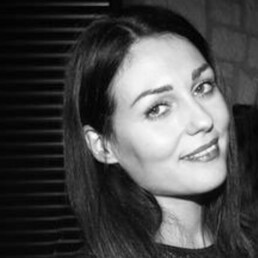
Céline Fernandez
With 15 years of experience in marketing and communications, Céline has worked for major companies such as the Hopscotch agency, the Galerie Lafayette Group, and several communications agencies. Since 2019, she has been managing the gallery's communications through its website, social media, and traditional media.
Contemporary Summer Highlights : the gallery's summer exhibition
A selection of contemporary artists working between figuration and abstraction
For this summer season, Galerie Hurtebize is presenting a unique exhibition showcasing contemporary artists with distinctive artistic styles. Entitled Contemporary Summer Highlights, this exhibition brings together eight artists whose works range from stylized figuration to visual narration, gestural abstraction, and experimentation with materials.
Organized in two distinct spaces, the exhibition establishes a strong dialogue between two major currents in contemporary art: contemporary figurative representation and abstract research.
Contemporary figuration: narration, symbolism, and culture
In the first room, three artists explore contemporary figurative art through very different but complementary approaches:
- Salifou Lindou offers compositions rich in contrasts, where drawing, collage, and visual symbols intertwine to evoke stories rooted in the African collective memory.
- Julien Colombier, meanwhile, deploys a graphic and decorative universe populated by stylized plant motifs, somewhere between abstraction and poetic figuration.
- Finally, Kim Duck Yong revisits the codes of traditional Korean painting through delicate and meditative pictorial marquetry.
Each of these artists offers a sensitive representation of reality, rooted in a strong cultural heritage and personal aesthetic research.
Abstraction: matter, gesture, and experimentation
In the second part of the exhibition, Galerie Hurtebize showcases artists whose work explores the expressive possibilities of materials and gestures:
- Bernard Bezzina works with paper as a sculptural material, playing with density, transparency, and light.
- Arthur Unger uses a rare pyrochemigram technique on copper, where chemistry becomes a tool for creation.
- Maryna Maryienko creates poetic abstraction through a secret technique that gives rise to unique organic textures.
- Jean-Jacques Marie continues the legacy of dripping with energetic gestural abstraction, where layers, movements, and colors are superimposed.
These works offer a true panorama of contemporary abstract creation, combining technical mastery and freedom of execution.
An exhibition to discover all summer long in Cannes
The Contemporary Summer Highlights exhibition is on display all summer long at the Hurtebize Gallery, located in the heart of Cannes, just a few steps from La Croisette.
🕦Opening hours: Monday to Saturday from 10 a.m. to 7 p.m.
📍Address: 17, La Croisette 06400 Cannes

Céline Fernandez
With 15 years of experience in marketing and communications, Céline has worked for major companies such as the Hopscotch agency, the Galerie Lafayette Group, and several communications agencies. For over four years, she has managed the gallery's communications through its website, social media, and traditional media.
Claude Venard - L'Atelier du Peintre (1962) I Galerie Hurtebize
Claude Venard‘s L’Atelier du Peintre (1962), presented at Galerie Hurtebize, embodies the expressive power and rigorous construction that characterize his work. This oil on canvas, included in the catalog of the Villa Tamaris Pacha exhibition in La Seyne-sur-Mer in 1991, perfectly embodies his pictorial language: a rigorous construction in which the balance between abstraction and figuration imposes itself with force.
A vibrant tribute to the painter's studio
In this studio scene, Venard deconstructs forms to reinvent pictorial reality, somewhere between masterful abstraction and free figuration.
He assembles the familiar elements of his world – easel, brushes, color tubes, playing cards and sheet music – in a structured tangle of powerful black lines and angular geometric shapes. His universe oscillates between poetic everydayness and controlled chaos, where every object becomes a pretext for plastic exploration.
Venard‘s studio is more than just a place to work: it’s a vibrant theater where objects dialogue, respond and merge in energetic composition.
In this work, the artist pays sensitive, pictorial homage to his own creative space, both sanctuary and experimental ground.
An expressive technique: the art of sculpting paint
As usual, Claude Venard‘s work is richly textured, almost sculptural. The paste is generous, the impasto assertive. Every brushstroke, every zone of color testifies to controlled energy. Here, the artist applies a dense, impastoed material, creating a relief-like texture that lends the whole a tactile force and expressive intensity. The surface of the canvas becomes a plastic playground where the paint takes shape, rises, thickens, until it surpasses the simple flatness of the painting.
This way of exalting matter gives the work a striking physicality, as if each element had been shaped by hand.
A composition built on color and form
The chromatic palette, characteristic of his work, plays on strong contrasts: deep greens, blues and vivid reds clash with the neutral tones of the background, while light seems to spring from light and ochre areas.
A product of the post-Cubist movement, Venard‘s painting is free, solidly constructed and free of academic conventions. His work on L’Atelier du Peintre is a striking demonstration of this: rigorous in structure, free in expression. L’Atelier du Peintre thus continues his commitment to painting that is both rooted in the cubist tradition and resolutely turned towards a personal, expressive vision of reality.
An emblematic work
This painting testifies to Venard‘s stylistic maturity in the early 1960s. It powerfully captures not only the place of creation, but the very spirit of creation: teeming, chaotic, luminous.
Through L’Atelier du Peintre, Claude Venard offers us a powerful look at his own craft, with the sincerity and intensity that made him one of the great names of twentieth-century French abstraction.
Claude Venard honored at Musée Jean Couty - Lyon
Recognition of Claude Venard‘s work continues to grow, as evidenced by the exhibition “CLAUDE VENARD. Le post-cubisme du bonheur”
at the Musée Jean Couty in Lyon until May 4, 2025. For the first time, the Musée Jean Couty is devoting an exhibition to him, bringing together some of his most emblematic and singular works.
👉 The work can be seen at the Hurtebize Gallery. For further information, please contact us.

Céline FERNANDEZ
With 15 years' experience in marketing and communications, Céline has worked for major companies such as Hopscotch, Groupe Galerie Lafayette and several communications agencies. For more than 4 years, she has been managing the gallery's communications through the website, social networks and traditional media.
Daniel Buren - Visual and Spatial Exploration at Galerie Hurtebize
Galerie Hurtebize is proud to present works by artists who have left their mark on art history. Daniel Buren, with his formal rigor and ability to transform spaces with simple repetitive patterns, is a valuable addition to our collection. Our gallery highlights works that question, transform and inspire. This work by Buren is an invitation to reconsider urban spaces, through the unique vision of a master of abstraction.
The Language of Shapes and Colors by Daniel Buren
Daniel Buren‘s work, presented here by Galerie Hurtebize, perfectly illustrates the radical artistic approach of one of the most influential contemporary artists. This piece is characterized by its emblematic use of geometric lines, notably red and white squares juxtaposed against a background where contrasts are accentuated by a deep black zone. These simple shapes, organized with rigor, create a fascinating play of perspectives that plunges the observer into an optical and spatial exploration.
What makes this work unique
Buren‘s work is immediately recognizable by the symmetry of its motifs and the minimalist use of red, white and black. The choice of a restricted palette highlights the structure of the work, evoking an interaction between the two-dimensional plane and three-dimensional space. The squares, carefully arranged, seem to unfold along two rising walls, amplifying the effect of depth and provoking a sense of visual movement.
The use of color is equally striking: the intense red contrasts with the pure white, creating an effect of light and volume, while the black part gives the impression of solidity and foundation, anchoring the work in space.
The Meaning of Work by Daniel Buren
Daniel Buren is known for his site-specific interventions and public works that play with architectural space. The theme of repeating geometric patterns is central to his practice, and can be seen in this piece exhibited at Galerie Hurtebize. Buren explores the concepts of limit, context, and how the environment influences the perception of art.
This work uses the codes of geometric abstraction and leads viewers to perceive walls as dynamic surfaces.
Why buy a Daniel Buren artwork?
Owning a work by Daniel Buren is first and foremost an immersion in the world of conceptual and minimalist art. His works are thought-provoking pieces that question spaces and the limits of the artistic framework. As a collector, owning a Buren means participating in a living and influential artistic history, where the visual language of abstraction meets spatial experimentation.
Collectors appreciate his works for their ability to transform the space in which they are presented, creating environments that stimulate critical and aesthetic thought. What’s more, Buren is an artist of international renown; his works are present in the world’s leading collections and exhibitions, guaranteeing both artistic and investment value.
The Visual Power of Buren
Daniel Buren‘s mastery of color and repetitive motifs continues to captivate and transform spaces. This work, with its unique combination of red, white and black, is a perfect illustration. At Galerie Hurtebize, we’re delighted to be able to offer our visitors a chance to see and acquire works that push the traditional boundaries of art. Come and explore, experiment and enrich your collection with one of the most iconic names in contemporary art.
Visit the Hurtebize Gallery to discover Daniel Buren
We invite you to discover this fascinating piece by Daniel Buren and many other works by major artists of the 20th and 21st centuries. Please do not hesitate to contact us to find out more about the works available or to arrange a personalized visit.
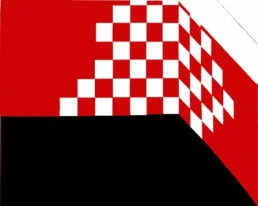

Céline FERNANDEZ
With 15 years' experience in marketing and communications, Céline has worked for major companies such as Hopscotch, Groupe Galerie Lafayette and several communications agencies. For over 5 years, she has been managing the gallery's communications through the website, social networks and traditional media.
Interview with Michel MOUSSEAU
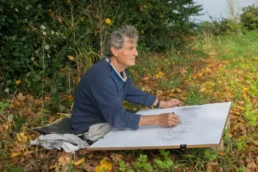
Discover our exclusive interview with Michel Mousseau, self-taught painter. To coincide with our exhibition “Michel Mousseau, The 60s“, the artist shares with us his unique career path, his artistic influences and his singular vision of painting. From his first aesthetic revelations to the nudes and still lifes that are emblematic of his work in the 60s, discover the thoughts and emotions that have shaped his work. Dive with us into Michel Mousseau‘s captivating universe and explore the themes and techniques that make his work a vibrant celebration of light and colour.
Q1 Can you tell us about your artistic career and what led you to become a painter?
I’m self-taught, with no formal artistic training. When I was a teenager at lycée, I was lucky enough to see some authentic paintings by Soutine and Modigliani at the home of a friend’s mother, who was a painter herself. It was a revelation.
Also at school, the short films on painting from all periods shown to us in art class by our teacher, Mr Jean Couy, a painter, were very formative for me. He introduced me to Cézanne.
I started drawing very early on, making lots of small, very precise drawings, which I unfortunately threw away. After that, I went to evening painting and drawing classes on Boulevard du Montparnasse in Paris. I was very assiduous but never received any advice from the painters or draughtsmen who taught there.
My first aesthetic emotion was discovering the ocean at Pornic. Coming from Paris by bike, I remember the violence of that dazzle, that horizon so far away from the sea.
I must add that what seems to me to have been very formative in my journey as a painter are the worlds of my two grandparents. One was a blacksmith, the other a baker. I have an image of the forge, it was a very dark place. And there was this glint of red iron on the anvil in the middle. These two worlds, one of Black and fire, the other powdery, flour-white, making everything light and silky, including the floor and walls, these two worlds created a chromatic base that I have never stopped developing.
Q2 Which artists or artistic movements have most influenced your work, particularly in the 60s?
I discovered Cézanne, Rembrandt and Gainsborough. Cézanne and Matisse are familiar to me. I discovered Les Ménines by Vélasquez at the Prado in Madrid. It was also a time when I saw major exhibitions devoted to Picasso and Poussin, whose The Seasons touched me deeply. But what really struck me first in painting was De Staël. Klee, Mondrian and Joan Mitchell are among the painters whose work particularly interests me. Jean Hélion was also one of my discoveries at the time.
Q3 What inspired you to create the nudes and still lifes presented in this exhibition?
I was struck by the work of Richard Lindner, for example. He’s an American painter. The fundamental problem with his work is the relationship between things and the flesh, the flesh being a particular element of what surrounds us. I loved painting nudes, with their design and movement.
I see my work as a painter as a quest, a search, to which I associate the notion of pleasure. For me, research and pleasure are two words that define my attitude to painting. I left the Sorbonne and the wonderful Jankélévitch to live painting.
Q4 Can you explain your choice of colours and textures in your 60s paintings?
I come back to the image of the forge. This question of origin, in many ways including the reference to Courbet, is at the heart of my research. Courbet and the Origin of the World rather than the Impressionists. Perhaps that’s where my taste for black comes from, because black generates light, receives light, whereas yellow reflects it. Yellow is brilliant, it’s like gold. Soulages only worked with black, but his blacks are often coloured.
Over a long period of time, I’ve been interested in the “Fabrique du Noir”, or the Black as internal light. In other words, black is either red or blue, hot or cold, it is itself a varied colour, whereas lemon yellow is always lemon yellow, it’s a bit silly, it only reflects lemon yellow.
I insist on the continuous nature of my work. If there are periods, they are periods of continuity, the continuity being light and therefore light from what I call “The true colour of things“. It’s a title given to me by the poet Georges Schehadé. The true colour of things, that’s what I’m looking for.
But let’s not forget the fundamental pleasure of spreading colour, of receiving colour in the eye – it’s mysterious, it’s magnificent.
Q5 How do you approach the theme of intimacy in your nudes?
My subject is painting. For me, it’s not about reproducing or representing “things”, an object, a body or a landscape, but about capturing what catches the light.
My Nudes have been described as “pensive”. Thoughtful, yes, in the sense that I don’t tell stories. I’d say more detached, with a certain contemplative distance. It’s completely sensual, in the sense that a human body is not an object but a receptor of light.
Painting is first and foremost about seeing and making others see. Revealing without getting bogged down in anecdote. Painting expresses reality in all its transience and strangeness. It gives to see, it is to be seen. My painting is neither descriptive, narrative nor explanatory. I don’t paint objects or nudes, but I paint the light on objects and bodies in relation to the space in which they are.
So there is no question of intimacy, even when the subject is a human body. The human body, along with its surroundings, is a place that is taken over by painting, which searches for and through itself.
I see continuity in my work, I repeat. Continuity in the search for light, for matter, for that which resists the superficial gaze.
To paint nudes is not to try to capture or provoke desire or eroticism; it’s to investigate the enigma of reality that the painter’s gesture attempts to define through form, texture and colour. It is up to the viewer, if they so wish, to interpret the motif, the subject if that is what interests them.
Q6 How did the 60s influence your art?
During the period when I painted the canvases you are exhibiting, I wasn’t at all on the lookout for political or other events. At that time I lived in an artistic and intellectual milieu that included Roland Topor, Olivier O. Olivier and the regulars at Castel. In the theatre, I worked with Georges Wilson, Georges Vitaly and Daniel M. Maréchal, saw Pierre Arditti, Claude Brasseur and Sylvia Montfort, and was in contact with gallery owners Margueritte Motte and Robert de Bolli. I met a lot of poets, including André Salmon and Georges Schehadé. I live between Paris, Brittany and the Var.
My annual visits to the Cotentin region began in 1964. There I rediscovered the immensity of the skies and the sea. This was to give a new direction to my work.
Q7 What message or emotion would you like to convey through your work?
Open your eyes. To look. Seeing, that’s my project. I’m an optical glutton. The viewer is free.
How can we not hope that art remains at the heart of our lives?
Q8 What do you think is the place of art in today’s society?
Today’s art is more oriented towards representation and illustration than towards exploration. Contemporary art is more about DIY. I would say that Picasso was a genius at tinkering.
I ask the question, what does it mean to ‘see’? Because if you can’t see any more, what’s left? There’s nothing left. What is dying, if not no longer seeing? In short, painting is like a touchstone for existence.
Painting is a gesture of recognition, a form of homage to Creation. It is also a privileged meeting place with oneself and with those who have contributed to making the world a living place.

Céline Fernandez
Forte d’une expérience de 15 ans dans le marketing et la communication, Céline a travaillé pour de grandes sociétés telles que le Public Système, le Groupe Galerie Lafayette et plusieurs agences de communications. Depuis plus de 4 ans, elle gère la communication de la galerie à travers le site internet, les réseaux sociaux et les médias traditionnels.
Francis GUERRIER, the Nature-Sculpture
From a line of artists, from his grandfather to his two daughters, Francis Guerrier was born in 1964 in Marseille and lives today in his childhood home in Eygalières, which he has decorated with a huge studio bathed in light.
More than the mastery of artistic techniques, his family environment transmitted to him a strong sensitivity to art. But he waited until the death of his painter father Raymond Guerrier to be able to call himself an artist and he chose sculpture, turning his back on the painting practiced by the Guerrier family for two generations.
He left for Paris at the age of 19 and, the following year, began his creative activity with the architect-scenographer Pierre-Henri Magnin, who introduced him to the world of decor and scenography and whom Francis considered his master.
He got married and became a father at a very young age, which led him to create his own company for the creation of sets and scenography for events at the age of 25 in order to provide for his family’s needs more serenely. For ten years, in order to meet his clients’ wishes, he had to master many tools and media: video, laser, sound and light installations, but also construction materials, wood and steel. A rich experience but restrictive because it is time-consuming and limiting: he wants to expand his field of creation, give free rein to his imagination and no longer simply honor orders.
In 2000, at the age of 36, he sold his company and sailed for 4 months in the Mediterranean to discover the sites listed as World Heritage by UNESCO, from Italy to Egypt through Syria. On his return, he knew he wanted to be a sculptor. He then made a break in his professional career, which was nevertheless flourishing, in order to feel in phase with his deepest values and to respond to the imperative need to return to his roots. At first, he settled in Paris in his grandfather’s studio, which was also André Derain‘s studio. He then discovered the painted work of his grandfather and this universe became his main inspiration. In 2002, he held his first exhibition of his sculptural work around the sky, dreams and memory, where he integrated light into the steel, wood, glass and copper that make up his creations.
But Francis Guerrier has a need for grandeur and dreams of creating a monumental work “that puts man in his place”. He also feels that nature and the light of the south are necessary for him. In 2015, he moved with his second wife to Eygalières and rediscovered his roots. While still working as a set designer to satisfy his passion for theater, he further developed his know-how and his own technique and could finally tackle the realization of sculptures of impressive dimensions, such as his 12-meter high Feather. In 2005, the Galerie Guigon in Paris allows him to present his new work of steel based on the folding and the curve.
"I don't model my sculptures, I work from a sheet of metal that I cut and shape. By honoring the material, by respecting its energy, its spring, its possible curvature, I reach balance, harmony, I find nature... And it is nature, in its purity but also its complexity, which is my first inspiration. Curves, moons, trajectories and spirals so often present in nature, from shells to galaxies, are my writing. I do not seek abstraction, but on the contrary, to get closer to the original forms."
The black steel sheet becomes his medium of choice. He developed a technique of incising the metal and cold bending of flat plates by which he seeks to honor the material and find balance and harmony after the struggle. His Euclidean forms are inspired by nature, the cosmos and the stars, and volume is created through folding.
"It is with the black steel sheet, hard and springy, that my exchange with the material is the strongest. My main work with steel consists of cutting it, but above all, bending it into a curve. If I draw, it is the steel that takes shape and creates its volumes by its energy."
Monumental and yet light, black and yet luminous, soft and angular, his sculptures with pure, sober and elegant lines are the result of a manufacturing process very personal to the artist who lets himself be guided by the resistance of the material in order to find a true synergy between the work and its environment and offer new perspectives in the landscape.
"From this struggle with metal, I win if I tame, if I honor the material, I reach balance, harmony, I find nature..."
Strong and energetic while being pure and sober, Francis Guerrier’s sculptures seduce us with the voluptuousness of their curves and the momentum of their lines. A true link between earth, sky and sea, they reflect the personality of their creator: “Head in the stars and feet on the ground”.
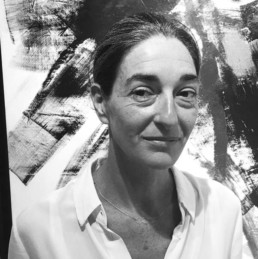
Maud Barral
After 15 years spent as the assistant of the famous gallerist Jean Ferrero, whose gallery has been the main center of creation for the artists of the School of Nice and the Nouveaux-Réalistes movements, Maud has then opened for 5 years her own gallery, supporting contemporary young artists. Then, she has decided to enter the Galerie Hurtebize, in 2015.
50th Antibes Art Fair - From 04.16 to 05.02 2022
50e SALON D’ANTIBES
From 04.16 to 05.02 2022
PLACE
Esplanade du Pré des Pêcheurs, Antibes
PUBLIC OPENING
From 10.30 A.M to 07.30 P.M
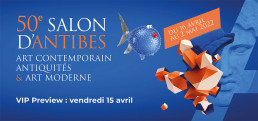
Raoul Dufy, Mon Docteur le Vin, 1936
In 1822, Nicolas revolutionized the world of wine by bottling precious nectars for home consumption.
Since 1930, in order to thank its most loyal customers, Etienne Nicolas publishes every year for Christmas a catalog illustrated by an artist. Today, this long series of 35 books is a real treasure for art and wine collectors. Over the years, Kees Van Dongen, Jean Hugo, Bernard Buffet, André Derain, Bernard Lorjou, Raymond Guerrier and Raoul Dufy, among others, have collaborated in the creation of these brochures.
We recently had the opportunity to acquire an exceptional set of 7 original drawings by Raoul Dufy reproduced in the 1936 catalog published by Nicolas & Draëger Establishment, a famous printer and engraver in Montrouge, entitled “Mon Docteur le Vin“. The 20 watercolors created for the occasion were the subject of an exhibition that same year at the Galerie Bernheim-Jeune in Paris. We also found an original edition of the book, signed by Dufy.
From the first page, the tone is given: “My Doctor the Wine? Yes, because his precepts, as old as the world, are justified more and more each day by science. After the First World War, Marshal Pétain, in his introduction “Homage to Wine”, indicates that “wine has been, for the combatants, the beneficial stimulant of the moral forces as well as the physical forces – thus it has largely contributed, in its own way, to the Victory”. And the benefits of wine are listed in the summary: vitamins and radioactivity of wine; wine against typhoid fever, depression, anemia, diabetes or obesity; wine for the kidneys, the maintenance of youth and aesthetics, character and morale; indispensable to writers, artists and athletes. And finally, wine makes men handsome and promotes longevity! The quotation of Professor P. PIERRET will serve as a conclusion: “Wine carries with it cheerfulness, strength, youth and health. It is sunshine in a bottle”. So, who better than Raoul Dufy to illustrate such a book?
« If I could express all the joy that is in me » Raoul Dufy
Painter of optimism, festivity and worldliness, Raoul Dufy has a marvelous look at the world and transmits through his colorful and poetic painting, a joyful feeling of well-being and life. As Pierre Camo says so well in “Dufy, l’Enchanteur” (ed. Marguerat, 1947) “Everything is fresh, lively, clear, joyful like spring in nature or youth in life”. The titles given to exhibitions and various tributes dedicated to the artist testify to this: “Raoul Dufy. Le Plaisir” (Museum of Modern Art, Paris, 2008); “Raoul Dufy. A Spectacle of Society” (Connaught Brown Gallery, London, 2016); “The Colors of Happiness” (Jean Cocteau Museum, Menton, 2017); “The Lightness of Raoul Dufy” (Angladon Museum, Avignon, 2017).
His style corresponds exactly to the spirit of “Mon Docteur le Vin“, a work linking humor, finesse and precision.
At the age of 13, the young Raoul imposed his choice to become a painter on his family of musicians and left his native Normandy to train at the Ecole des Beaux-Arts in Paris. Influenced at first by the Impressionists and then by the brilliance of color in the Fauves, he admired Cézanne more than anyone else and it was in the Provençal lands dear to Cézanne that he found his own language and developed his principle of “light-color”.
"In 1919 Dufy suddenly became Dufy. The hand is freed, his line gains in flexibility and strength. Above all, he devoted himself to watercolor, which allowed him to render the beauty of the landscapes of Provence, their transparencies and their lights. (...) His painting acquires a new dynamism. The forms gain in lightness and balance. His drawing is faster, more exalted. He feels a desire to create which reflects all his joy of artist conscious to have reached maturity and all the happiness of a world henceforth liberated ".
Fanny Guillon Laffaille
The essential characteristics of Raoul Dufy’s style were born and would never leave him: dissociation of line and color; sketched but dynamic and lively figures; chubby and voluptuous curves; simple, supple and expressive lines; flamboyance of color that becomes light. In 1936, the year of the publication of “Mon Docteur le Vin”, Dufy was already known worldwide and had personal exhibitions in New York, Brussels, Prague…
Endowed with an exceptional gift of drawing and coloring, it is through drawing and more precisely through watercolor that he reveals his true talent and releases his lively and graceful gesture. From the 1930s, Dufy gave more and more space to his graphic work and worked on the possibilities offered by the use of his “puddles of color” that precede his line.
"Any drawing by Raoul Dufy is in some way his signature
and what is agreed to call inimitable signature."Jean Cocteau
Raoul Dufy does not seek to represent materiality but offers a very free and subjective interpretation of his subject where reality and imagination intersect. If one finds recurring themes and motifs in his work (orchestras, landscapes, portraits, horse races…), the artist is eclectic and expresses himself through various media, multiplying experiences: drawing, painting, sculpture but also decorative arts, illustration, tapestry, sets and costumes. His calligraphic surety, the simplicity and purity of his subject, his extraordinary sense of composition, the suppleness of his lines and the brightness of the colors dissociated from the line will remain recognizable among all, whatever the chosen support.
A relentless worker, he produced no less than 4,000 drawings and 2,000 paintings, among other ceramics, fabrics, tapestries… a fruitful career if ever there was one, and success and international recognition were at hand! One year before his death, in 1952, the XXVIth Venice Biennale awarded him the Grand Prize for Painting to crown his work.
Discover an extract of the book “Mon Docteur le Vin”.

Maud Barral
Après une expérience de 15 ans passés aux côtés de Jean Ferrero, directeur de la galerie historique de l’École de Nice et des Nouveaux Réalistes, Maud a ensuite défendu la jeune création contemporaine durant 5 ans, au sein de sa propre galerie, avant de rejoindre l’équipe de la Galerie Hurtebize en 2015.
Venet's drawing
Bernar VENET, a French artist born in 1941 and living between France and the United States since the 1960s, is today known worldwide for his sculptures and recognised for his monumental installations in the public domain.
We would like to focus here on another part of his compositions: his graphic work. We will base this article on two works on paper recently acquired by the gallery, which perfectly illustrate the importance of drawing in the sculptor’s creative process.
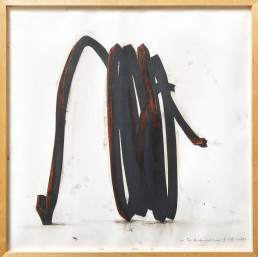
Bernar VENET – Two Undetermined Lines, 1989 – Oil pastels on paper – 76.2 x 76.2 cm
“First, I have a vision. Then I make a small drawing with the main precaution being the question of proportions “.
From his first artistic experiences, Bernar VENET gives the drawing a predominant and omnipresent place. From mathematical formulas written with ink on large papers, to industrial technical diagrams presenting the physical characteristics of an object produced and shown at the same time in volume, Venet’s graphic works are inseparable from his sculptures.
Like many artists, drawing is the first stage in Bernar Venet’s work and he will build his sculptural project through it. Moreover, the sculptor can be felt behind each of the artist’s sketches: the relief and perspectives make each drawing a wall sculpture. The flat work seems to be already present in volume, it seems to come out of its frame. Here, the preparatory drawing is not a sketch but a fully-fledged, finished work that stands on its own and presents us with the essence of the subject to which Venet will give life. The movement, relief, texture and colours of the pastel give us the grainy, rusty aspect of the Corten steel that will constitute the material of the sculpture to be born. The attention is already entirely concentrated on the form, no superfluous detail disturbs the eye. Ingres gave this advice to his students: “Have the figure you want to represent entirely in your eyes and in your mind, and let the execution be nothing more than the accomplishment of this already possessed and preconceived image”. With a lively, sober, powerful and elegant gesture, Venet goes straight to his goal, follows his Line, a central element of his work since the 1960s, the volume of which he already feels, and remains faithful to what he calls the principle of equivalence, which makes it possible to transmit the same content through different channels.
The second stage is the casting of the sculpture in black or Corten steel according to the drawing. Then, in a third step, the artist will try to give yet another vision of his work, this time from a photographic view of his sculpture.
In Venet’s case, there is an absolute circularity between drawing, sculpture and photography. The form and its metaphors are contiguous and reflect the artist’s desire to achieve the absolute object, one whose aspect refers only to itself without expressiveness, totally neutral, depersonalised. This was already the aim of Bernar Venet during his first artistic experiments based on the use of diagrams and mathematical formulas, or also through his performance around the “coal pile”: “The charcoal, placed freely in a heap, freed the sculpture from the apriorities of the composition imposed by the artist. The material, always poor (coal, tar, steel…), used for its own capacities, decides on its own form which will be different with each use, thus allowing the artist’s personality to disappear behind his work. Through the raw and industrial materials he chooses, Venet further emphasises the radical and self-referential nature of his research: the work must speak only of itself and not of the artist. It is on this monosemia principle that he has based his thinking since the beginning.
Bernar VENET – Indeterminate Line, 2016 – Photograph and charcoal on paper – 220 x 153 cm
This Indeterminate Line, created in 2016, is entirely representative of the style and strength of Venet’s work: at once minimal and monumental, even colossal, the line takes over the space with its presence and movement. Here we are faced with what could be described as the third stage of his work: after the preparatory drawing and the making of the sculpture, the artist seeks to give another vision of this volume. He then chooses an angle of view which he fixes photographically and reworks into a flat. The photo is then cut out following the contours of the sculptural form, pasted onto a large white paper and reworked with charcoal. This tool, made from charcoal (well, look at that…), used since prehistoric times in cave art, which is as raw as it gets, is generally associated with preliminary work because it is very easily erased. Here again, Venet goes against the grain. He glorifies charcoal through its use in the final work. The specific characteristics of charcoal allow him to add depth to his work and to play with light by varying the value of the black, more or less blurred. The rough and raw texture of charcoal can also recall the feel of steel. And the circle is complete!
«Expanding the field of the visual world»
Bernar Venet became an artist at a time when lyrical abstraction was exploding in France and conceptual art in the United States. He did not adhere to these movements and sought something else to broaden the field of creation. He therefore found his inspiration elsewhere, in disciplines outside the art world such as mathematics, geometry and physics.
His work will develop around a theme: the Line, which will become straight, curved, indeterminate before being transformed into Arcs and Angles. From the outset, his work was radical, even austere, compared to the generally lyrical and colourful abstract art of the 1960s. Using black and industrial materials, with a minimal and deliberately inexpressive gesture, he wanted to achieve the absolute object, one whose form would refer only to itself and not to the artist’s “style”. He remained faithful to the initial principles of his creation (principle of equivalence, refusal of aesthetics and monosemia principle) on which he based a protean work: paintings, sculptures, drawings, photographs, architecture, poetry, sound works, films…
A major artist of conceptual and minimal art, the father of informal art born with his “coal pile “, Bernar VENET is today present in some sixty museums throughout the world and receives numerous public and private commissions for permanent and often monumental installations.

Maud Barral
After 15 years spent as the assistant of the famous gallerist Jean Ferrero, whose gallery has been the main center of creation for the artists of the School of Nice and the Nouveaux-Réalistes movements, Maud has then opened for 5 years her own gallery, supporting contemporary young artists. Then, she has decided to enter the Galerie Hurtebize, in 2015.



